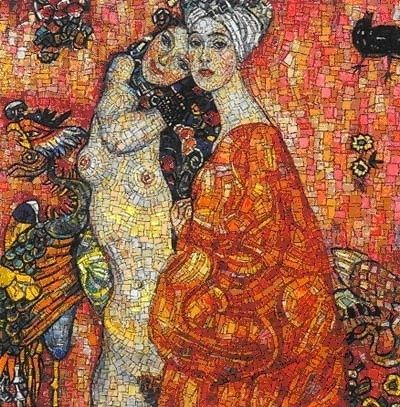Mosaic (fr. mosaïque — something dedicated to the muses) is a type of monumental and decorative applied art, which involves creating an image by connecting and fixing coloured stones, fragments of tiles or smalt on a certain surface. There are Roman, Florentine and Byzantine mosaics.

The first mosaic panels adorned the temples and palaces of Messapotamia and were composed of painted clay "zigzags" attached to the surface with a clay mortar. These plates were laid out in the form of various geometric shapes in black, red and white. In the era of Antiquity, mosaics schematically depicting stories about people, mythological heroes and animals consisted of pebbles. With the beginning of the Hellenistic era, artists began to use coloured glass in mosaics. In the Byzantine Empire
, this type of decoration reached its peak: on a gold background, they laid out smaller stones than on the first panels.
With the adoption of Christianity in Ruthenia, they also began to copy mosaic masonry, but it did not gain wide popularity for economic reasons: it was too expensive to import material from Constantinople. In the 1840s, students of the Imperial Academy of Arts were sent to Rome to study this art, and upon their return, they organized the first Russian studio for making mosaics of smalt. In Europe, during the Rococo era, there was a fashion for mosaics of sea shells and beads. In the Orient, Muslim temples were decorated with fine glass.
Today mosaics are not only an element of architectural decoration, but are also used in various types of applied arts. This technique is a powerful expressive tool.
With the adoption of Christianity in Ruthenia, they also began to copy mosaic masonry, but it did not gain wide popularity for economic reasons: it was too expensive to import material from Constantinople. In the 1840s, students of the Imperial Academy of Arts were sent to Rome to study this art, and upon their return, they organized the first Russian studio for making mosaics of smalt. In Europe, during the Rococo era, there was a fashion for mosaics of sea shells and beads. In the Orient, Muslim temples were decorated with fine glass.
Today mosaics are not only an element of architectural decoration, but are also used in various types of applied arts. This technique is a powerful expressive tool.







